A New Physically Meaningful Threshold of Sample Entropy for Detecting Cardiovascular Diseases
Abstract
1. Introduction
2. Methods
2.1. Sample Entropy
2.2. How Vector Similarity Changes When r Changes
2.3. Selection of r Value: Traditional or Physically Meaningful
2.4. New Calculate Method for SampEn
3. Data and Experiment
3.1. Data
3.2. Experiment Scheme
3.3. Statistical Analysis
- Sensitivity: Se = TP/(TP+FN)
- Specificity: Sp = TN/(TN+FP)
3.4. Stability Test
4. Results
4.1. Results of CHF & NSR
4.2. Results of AF & Non-AF
4.3. Stability Analysis
5. Discussion
Author Contributions
Funding
Acknowledgments
Conflicts of Interest
References
- Pincus, S.M. Approximate entropy as a measure of system complexity. Proc. Natl. Acad. Sci. USA 1991, 88, 2297–2301. [Google Scholar] [CrossRef] [PubMed]
- Pincus, S.M.; Goldberger, A.L. Physiological time-series analysis: What does regularity quantify? Am. J. Physiol. Heart Circ. Physiol. 1994, 266, H1643–H1656. [Google Scholar] [CrossRef] [PubMed]
- Liu, C.Y.; Liu, C.C.; Shao, P.; Li, L.P.; Sun, X.; Wang, X.P.; Liu, F. Comparison of different threshold values r for approximate entropy: Application to investigate the heart rate variability between heart failure and healthy control groups. Physiol. Meas. 2011, 32, 167–180. [Google Scholar] [CrossRef] [PubMed]
- Richman, J.S.; Moorman, J.R. Physiological time-series analysis using approximate entropy and sample entropy. Am. J. Physiol. Heart Circ. Physiol. 2000, 278, H2039–H2049. [Google Scholar] [CrossRef] [PubMed]
- Ho, K.K.; Moody, G.B.; Peng, C.K.; Mietus, J.E.; Larson, M.G.; Levy, D.; Goldberger, A.L. Predicting survival in heart failure case and control subjects by use of fully automated methods for deriving nonlinear and conventional indices of heart rate dynamics. Circulation 1997, 96, 842. [Google Scholar] [CrossRef] [PubMed]
- Liu, C.Y.; Gao, R. Multiscale entropy analysis of the differential rr interval time series signal and its application in detecting congestive heart failure. Entropy 2017, 19, 251. [Google Scholar]
- Castiglioni, P.; Di Rienzo, M. How the threshold “r” influences approximate entropy analysis of heart-rate variability. Comput. Cardiol. 2008, 35, 561–564. [Google Scholar]
- Zhao, L.N.; Wei, S.S.; Zhang, C.Q.; Zhang, Y.T.; Jiang, X.E.; Liu, F.; Liu, C.Y. Determination of sample entropy and fuzzy measure entropy parameters for distinguishing congestive heart failure from normal sinus rhythm subjects. Entropy 2015, 17, 6270–6288. [Google Scholar] [CrossRef]
- Pincus, S.M. Assessing serial irregularity and its implications for health. Ann. N. Y. Acad. Sci. 2001, 954, 245–267. [Google Scholar] [CrossRef]
- Lake, D.E.; Richman, J.S.; Griffin, M.P.; Moorman, J.R. Sample entropy analysis of neonatal heart rate variability. Am. J. Physiol. Regul. Integr. Comp. Physiol. 2002, 283, R789–R797. [Google Scholar] [CrossRef]
- Lewis, M.J.; Short, A.L. Sample entropy of electrocardiographic rr and qt time-series data during rest and exercise. Physiol. Meas. 2007, 28, 731–744. [Google Scholar] [CrossRef] [PubMed]
- Liu, C.Y.; Li, K.; Zhao, L.N.; Liu, F.; Zheng, D.C.; Liu, C.C.; Liu, S.T. Analysis of heart rate variability using fuzzy measure entropy. Comput. Biol. Med. 2013, 43, 100–108. [Google Scholar] [CrossRef] [PubMed]
- Zhao, L.; Liu, C.; Wei, S.; Shen, Q.; Zhou, F.; Li, J. A new entropy-based atrial fibrillation detection method for scanning wearable ecg recordings. Entropy 2018, 20, 904. [Google Scholar] [CrossRef]
- Lake, D.E.; Moorman, J.R. Accurate estimation of entropy in very short physiological time series: The problem of atrial fibrillation detection in implanted ventricular devices. Am. J. Physiol. Heart Circ. Physiol. 2011, 300, H319. [Google Scholar] [CrossRef] [PubMed]
- Zhang, T.; Yang, Z.; Coote, J.H. Cross-sample entropy statistic as a measure of complexity and regularity of renal sympathetic nerve activity in the rat. Exp. Physiol. 2007, 92, 659–669. [Google Scholar] [CrossRef] [PubMed]
- Aktaruzzaman, M.; Sassi, R. Parametric estimation of sample entropy in heart rate variability analysis. Biomed. Signal. Process. Control. 2014, 14, 141–147. [Google Scholar] [CrossRef]
- Mayer, C.C.; Bachler, M.; Hörtenhuber, M.; Stocker, C.; Holzinger, A.; Wassertheurer, S. Selection of entropy-measure parameters for knowledge discovery in heart rate variability data. BMC Bioinform. 2014, 15, S2. [Google Scholar] [CrossRef]
- Pincus, S.M.; Huang, W.M. Approximate entropy: Statistical properties and applications. Commun. Stat. Theory Methods 1992, 21, 3061–3077. [Google Scholar] [CrossRef]
- Costa, M.; Goldberger, A.L.; Peng, C.K. Multiscale entropy analysis of biological signals. Phys. Rev. E 2005, 71, 021906. [Google Scholar] [CrossRef]
- Yentes, J.M.; Hunt, N.; Schmid, K.K.; Kaipust, J.P.; McGrath, D.; Stergiou, N. The appropriate use of approximate entropy and sample entropy with short data sets. Ann. Biomed. Eng. 2013, 41, 349–365. [Google Scholar] [CrossRef]
- Aboy, M.; Cuesta-Frau, D.; Austin, D.; Mico-Tormos, P. Characterization of Sample Entropy in the Context of Biomedical Signal Analysis. In Proceedings of the 2007 29th Annual International Conference of the IEEE Engineering in Medicine and Biology Society, Lyon, France, 22–26 August 2007; pp. 5942–5945. [Google Scholar]
- Liu, C.; Murray, A. Applications of complexity analysis in clinical heart failure. In Complexity and Nonlinearity in Cardiovascular Signals; Barbieri, R., Scilingo, E.P., Valenza, G., Eds.; Springer International Publishing: Cham, Germany, 2017; pp. 312–316. [Google Scholar]
- Goldberger, A.L.; Amaral, L.A.; Glass, L.; Hausdorff, J.M.; Ivanov, P.C.; Mark, R.G.; Mietus, J.E.; Moody, G.B.; Peng, C.K.; Stanley, H.E. Physiobank, physiotoolkit, and physionet: Components of a new research resource for complex physiologic signals. Circulation 2000, 101, 215–220. [Google Scholar] [CrossRef] [PubMed]
- Kim, S.G.; Yum, M.K. Decreased rr interval complexity and loss of circadian rhythm in patients with congestive heart failure. Jpn. Circ. J. 2000, 64, 39–45. [Google Scholar] [CrossRef] [PubMed]
- Xie, H.B.; He, W.X.; Liu, H. Measuring time series regularity using nonlinear similarity-based sample entropy. Phys. Lett. A 2008, 372, 7140–7146. [Google Scholar] [CrossRef]
- Malik, M.; Camm, A.J. Heart rate variability. Clin. Cardiol. 1990, 13, 570–576. [Google Scholar] [CrossRef] [PubMed]
- Musialikłydka, A.; Sredniawa, B.; Pasyk, S. Heart rate variability in heart failure. Heart Fail. Rev. 1998, 2, 235–244. [Google Scholar]
- Friedman, H.S. Heart rate variability in atrial fibrillation related to left atrial size. Am. J. Cardiol. 2004, 93, 705–709. [Google Scholar] [CrossRef] [PubMed]
- Liu, C.Y.; Li, L.P.; Zhao, L.N.; Zheng, D.C.; Li, P.; Liu, C.C. A combination method of improved impulse rejection filter and template matching for identification of anomalous intervals in electrocardiographic rr sequences. J. Med. Biol. Eng. 2012, 32, 245–250. [Google Scholar] [CrossRef]
- Alcaraz, R.; Abásolo, D.; Hornero, R.; Rieta, J.J. Optimal parameters study for sample entropy-based atrial fibrillation organization analysis. Comput. Methods Programs Biomed. 2010, 99, 124–132. [Google Scholar] [CrossRef]
- Liu, C.; Oster, J.; Reinertsen, E.; Li, Q.; Zhao, L.; Nemati, S.; Clifford, G.D. A comparison of entropy approaches for af discrimination. Physiol. Meas. 2018, 39, 74002. [Google Scholar] [CrossRef]
- Behbahani, S. Investigation of Adaptive Filtering for Noise Cancellation inECG signals. In Proceedings of the Second International Multi-Symposiums on Computer and Computational Sciences (IMSCCS 2007), Iowa City, IA, USA, 13–15 August 2007; pp. 144–149. [Google Scholar]
- Molina-Pico, A.; Cuesta-Frau, D.; Aboy, M.; Crespo, C.; Miro-Martinez, P.; Oltra-Crespo, S. Comparative study of approximate entropy and sample entropy robustness to spikes. Artif. Intell. Med. 2011, 53, 97–106. [Google Scholar] [CrossRef]
- Udhayakumar, R.K.; Karmakar, C.; Palaniswami, M. Understanding irregularity characteristics of short-term hrv signals using sample entropy profile. IEEE Trans. Biomed. Eng. 2018, 65, 2569–2579. [Google Scholar] [CrossRef] [PubMed]
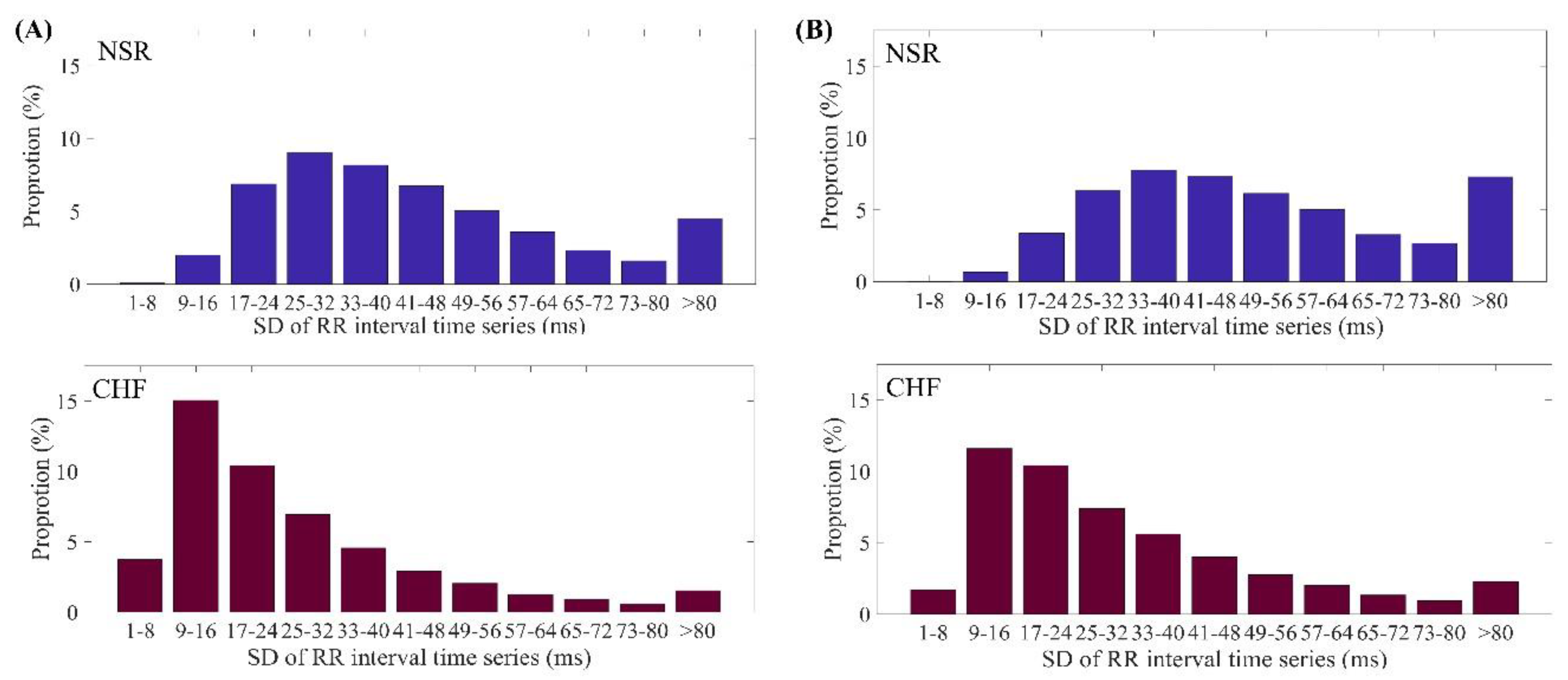
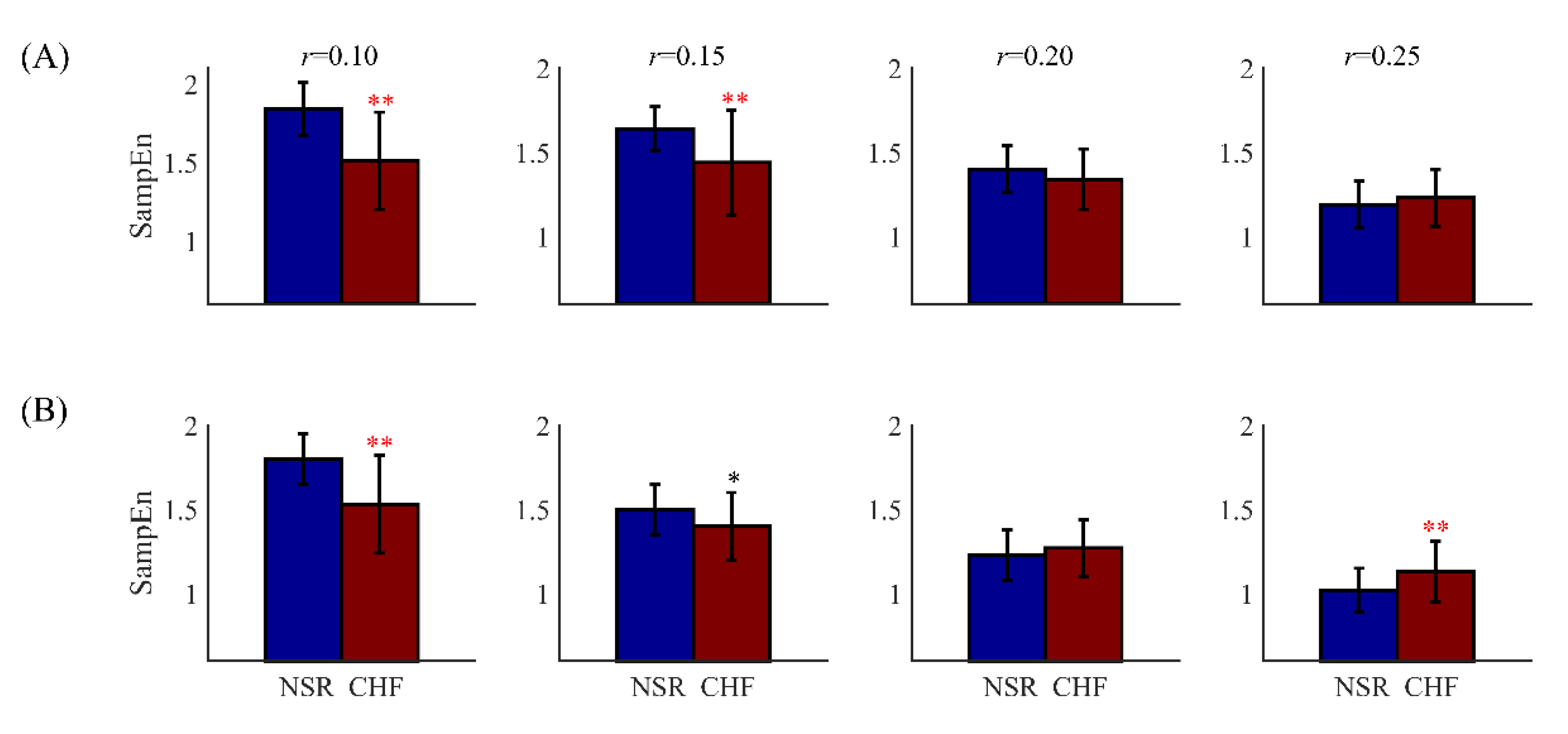
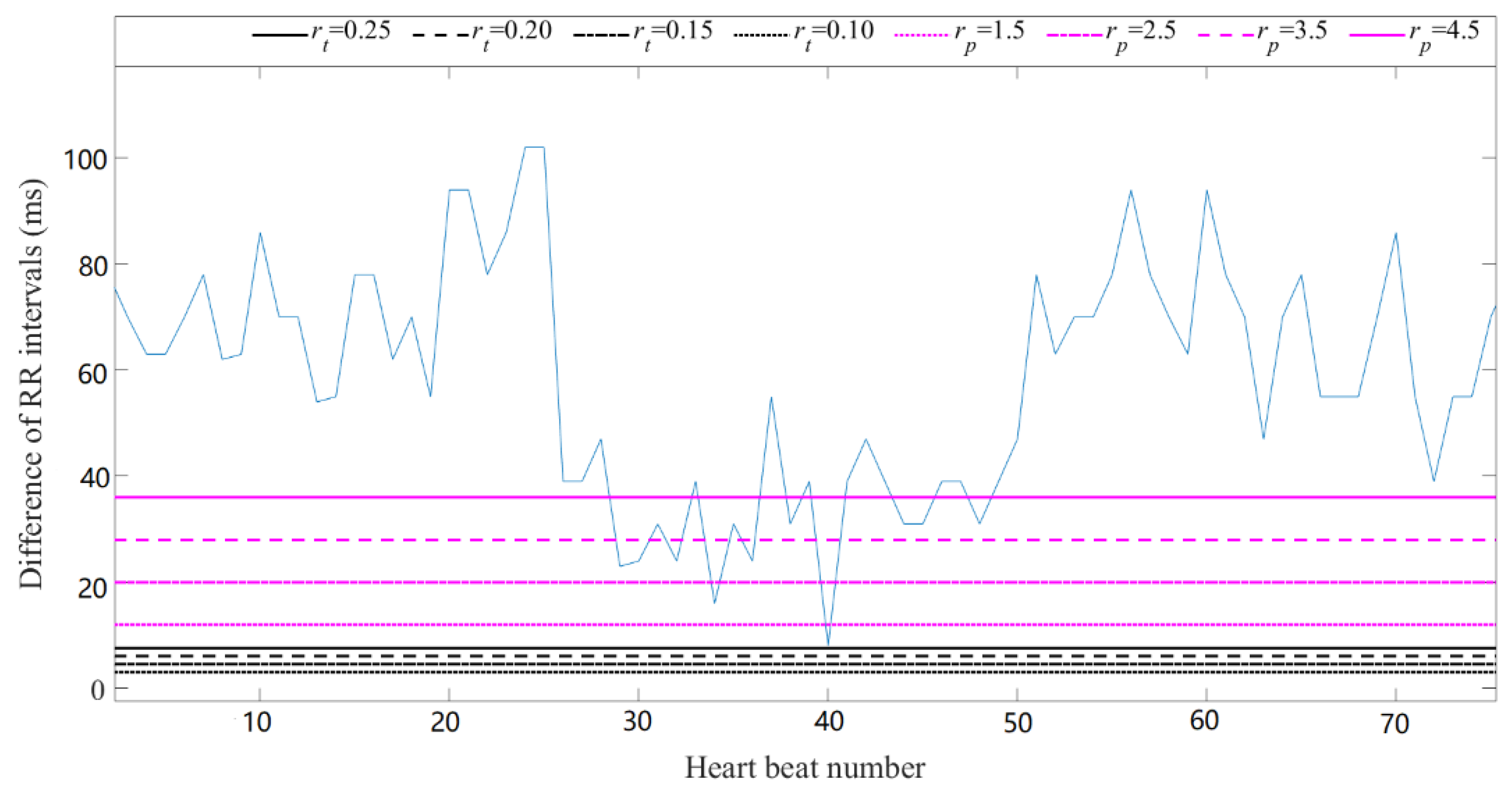
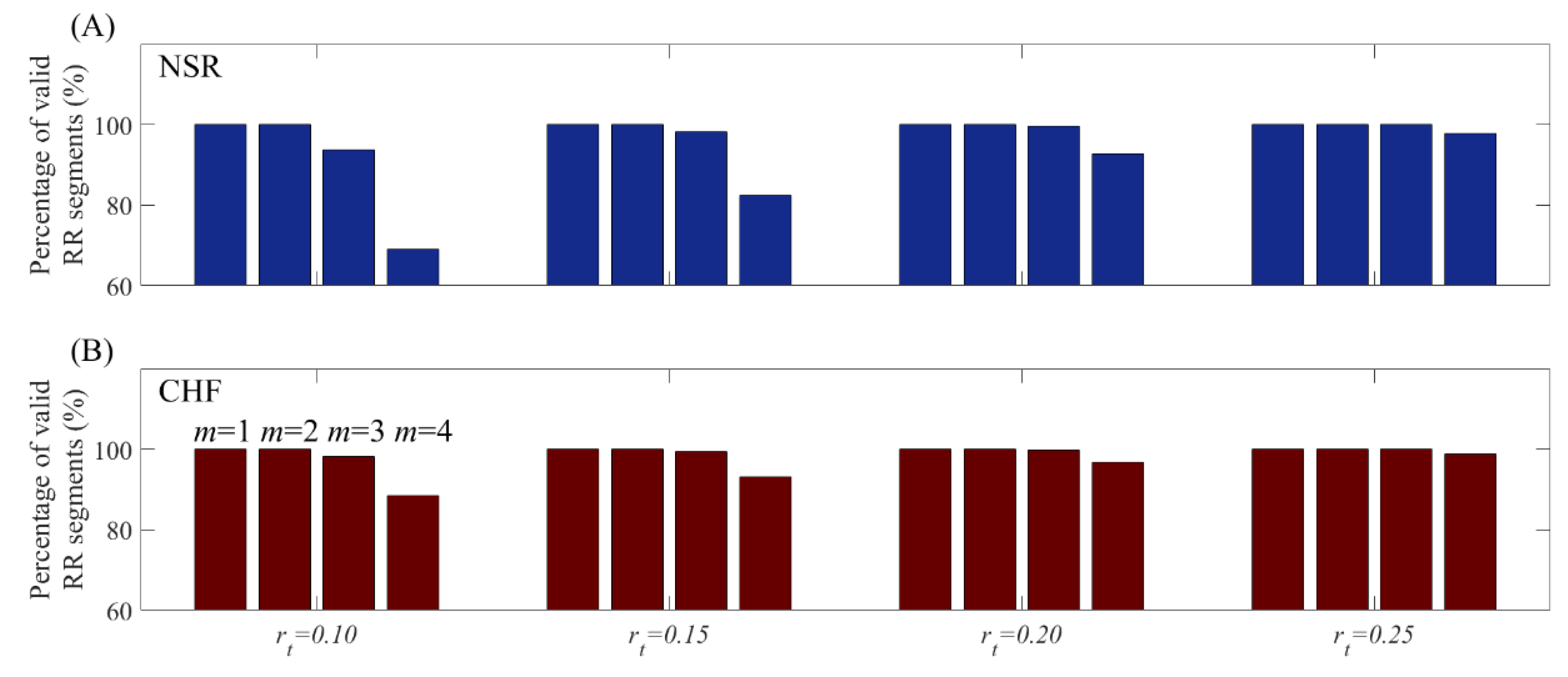
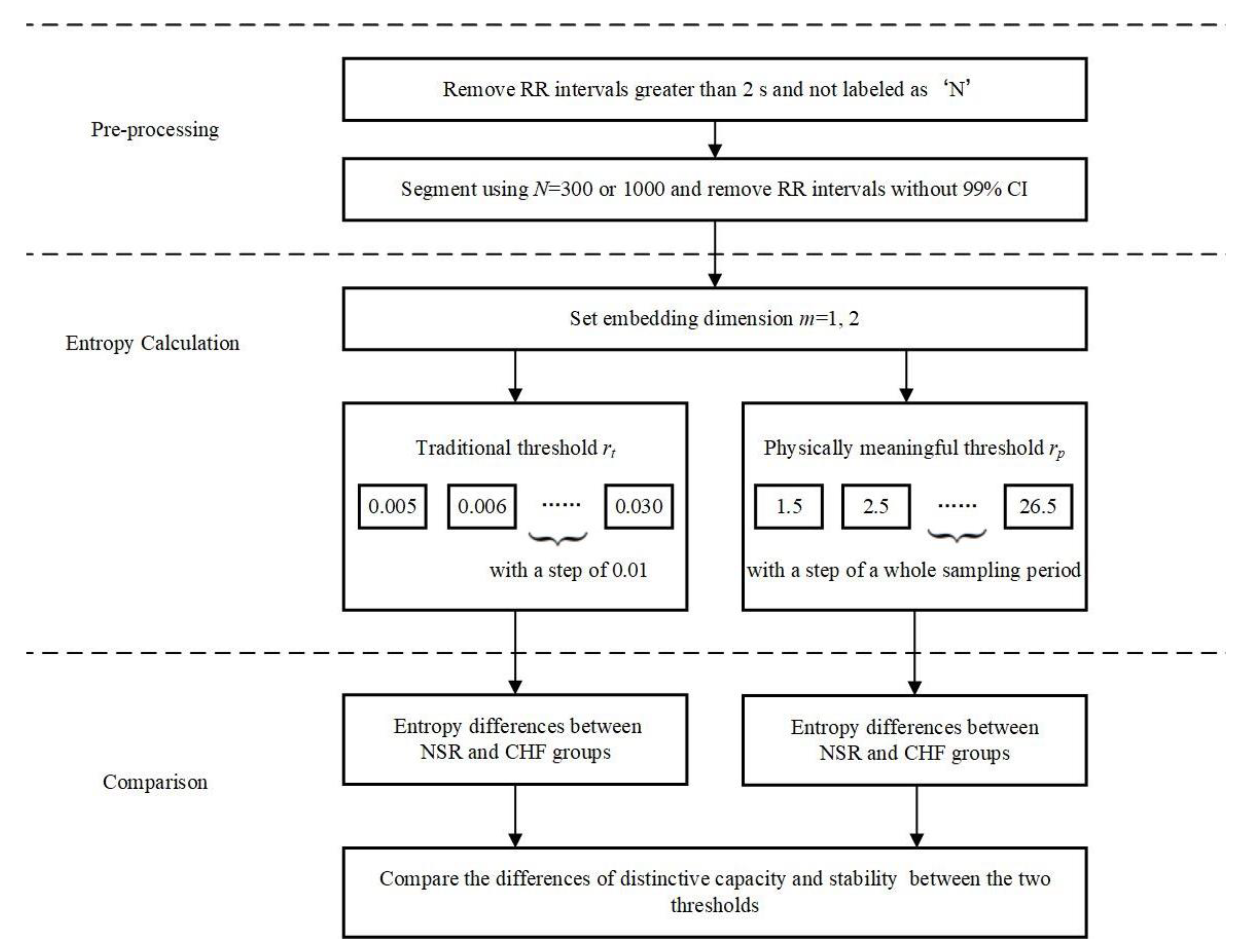
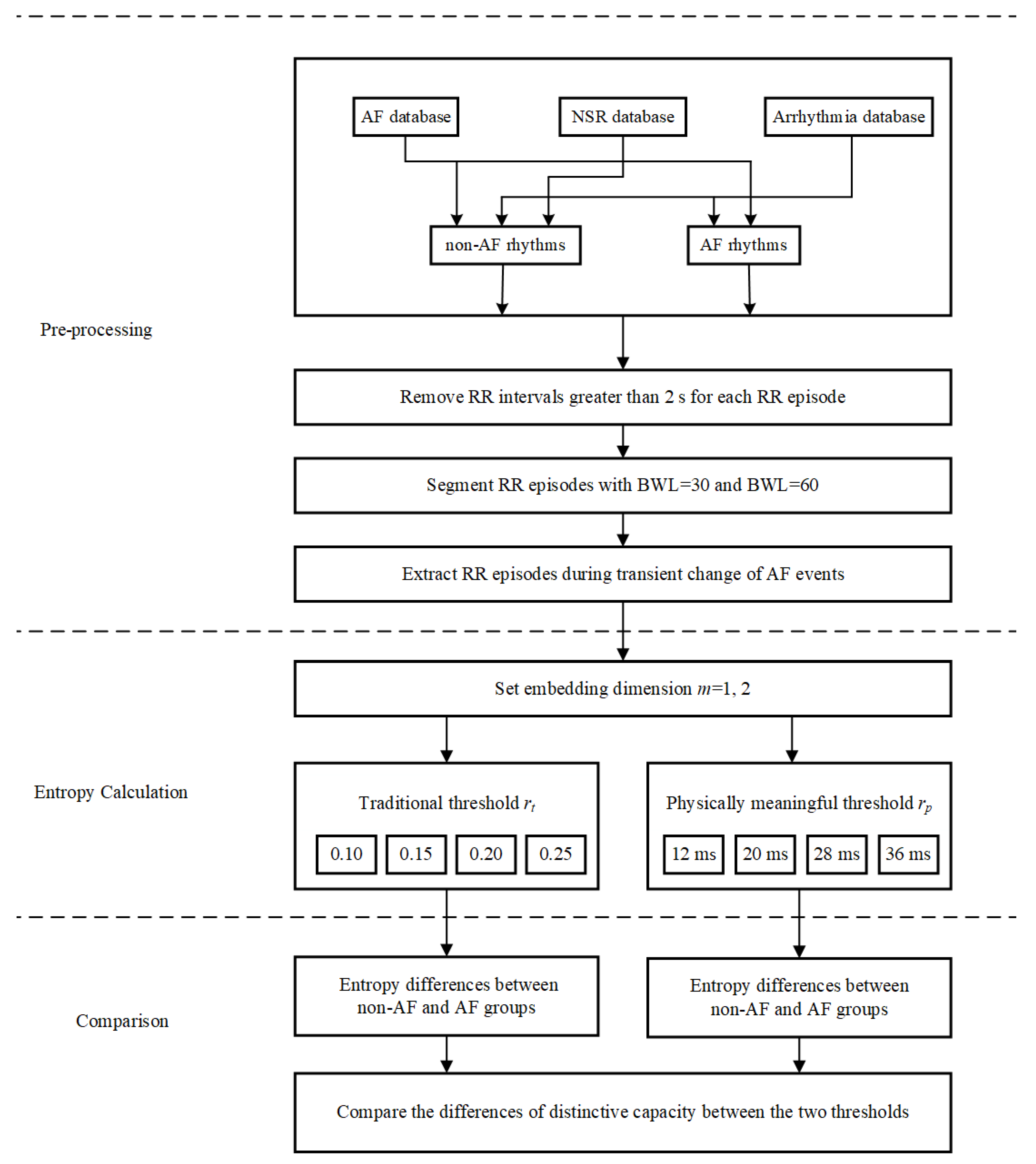
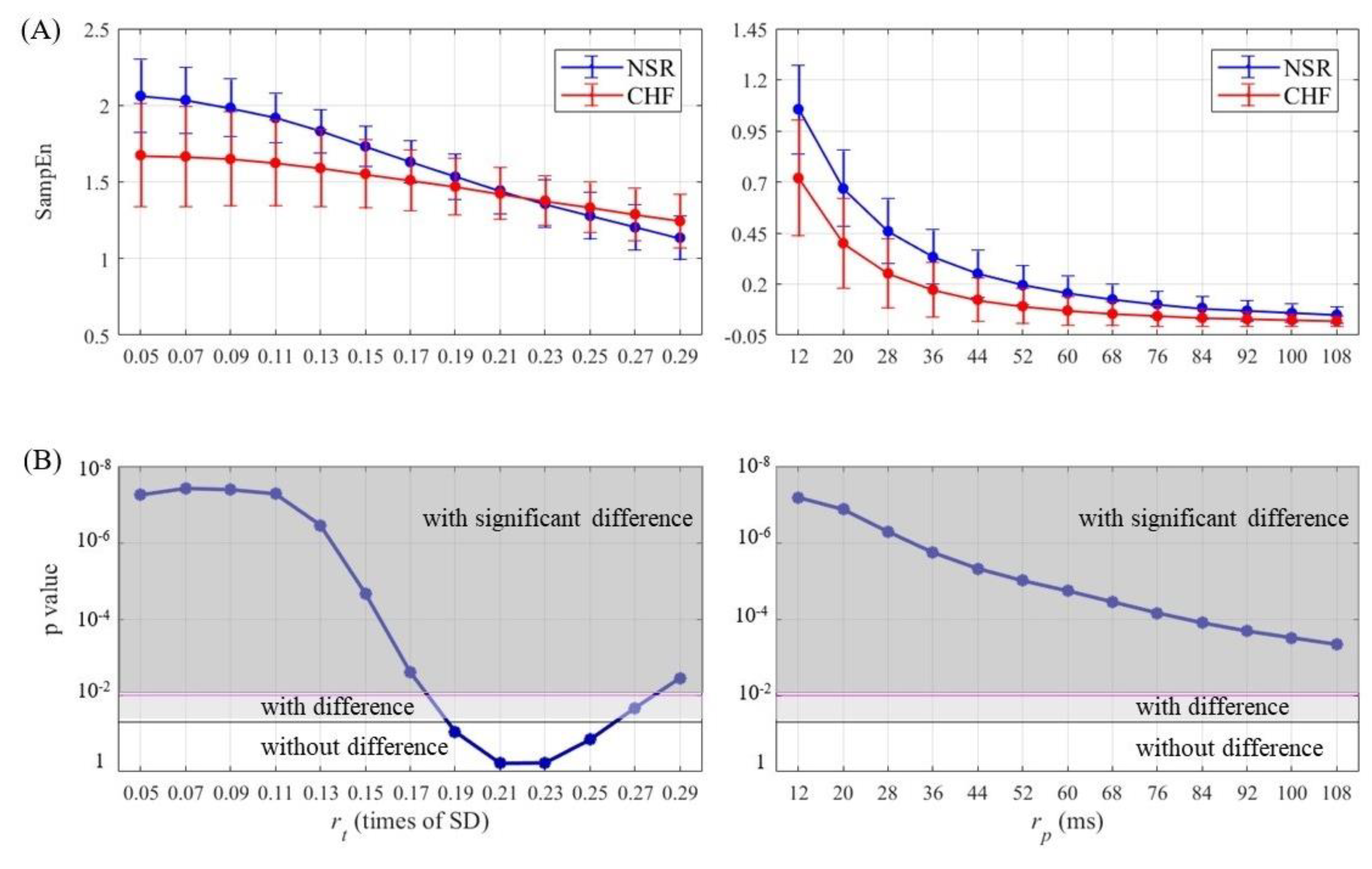
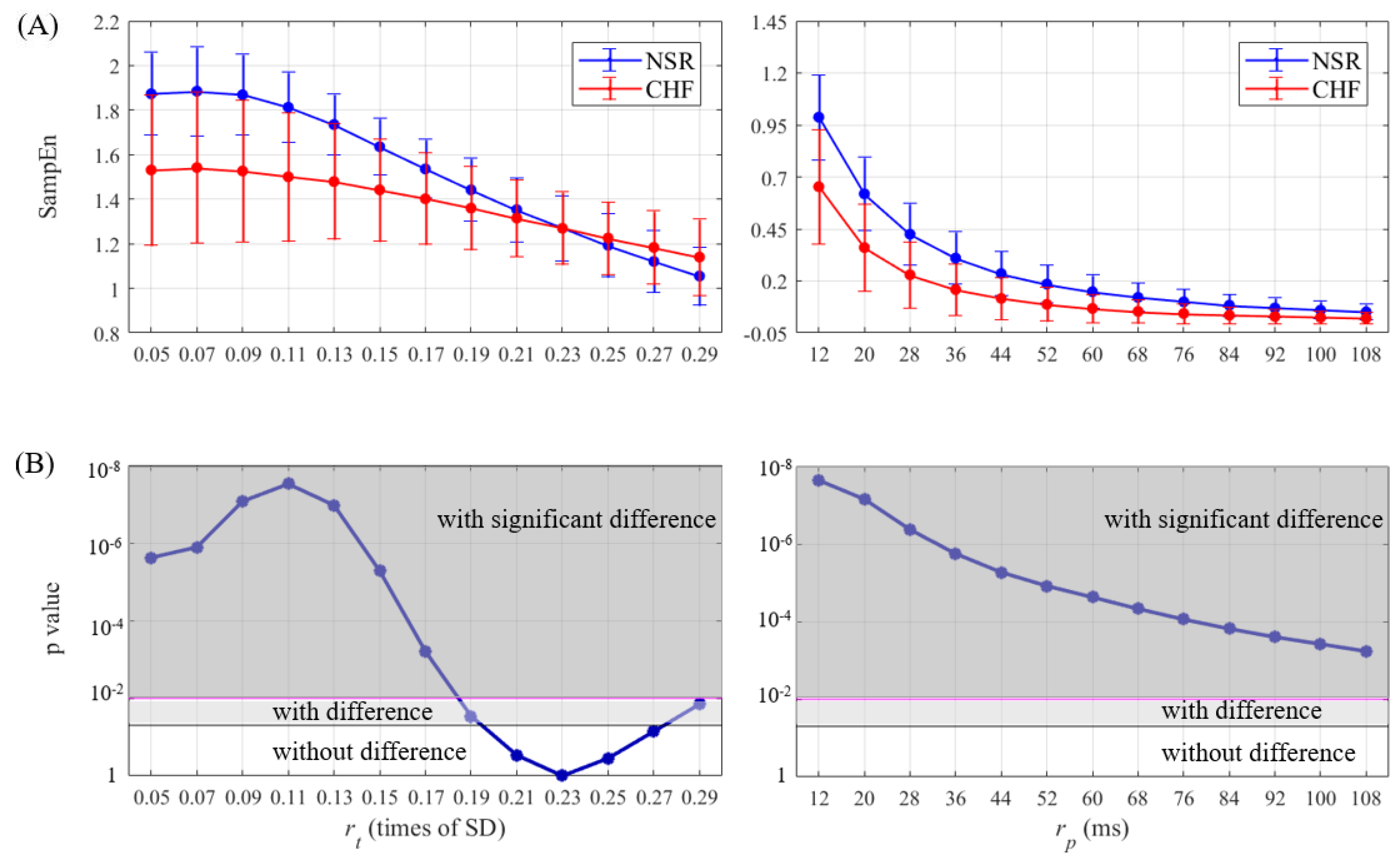
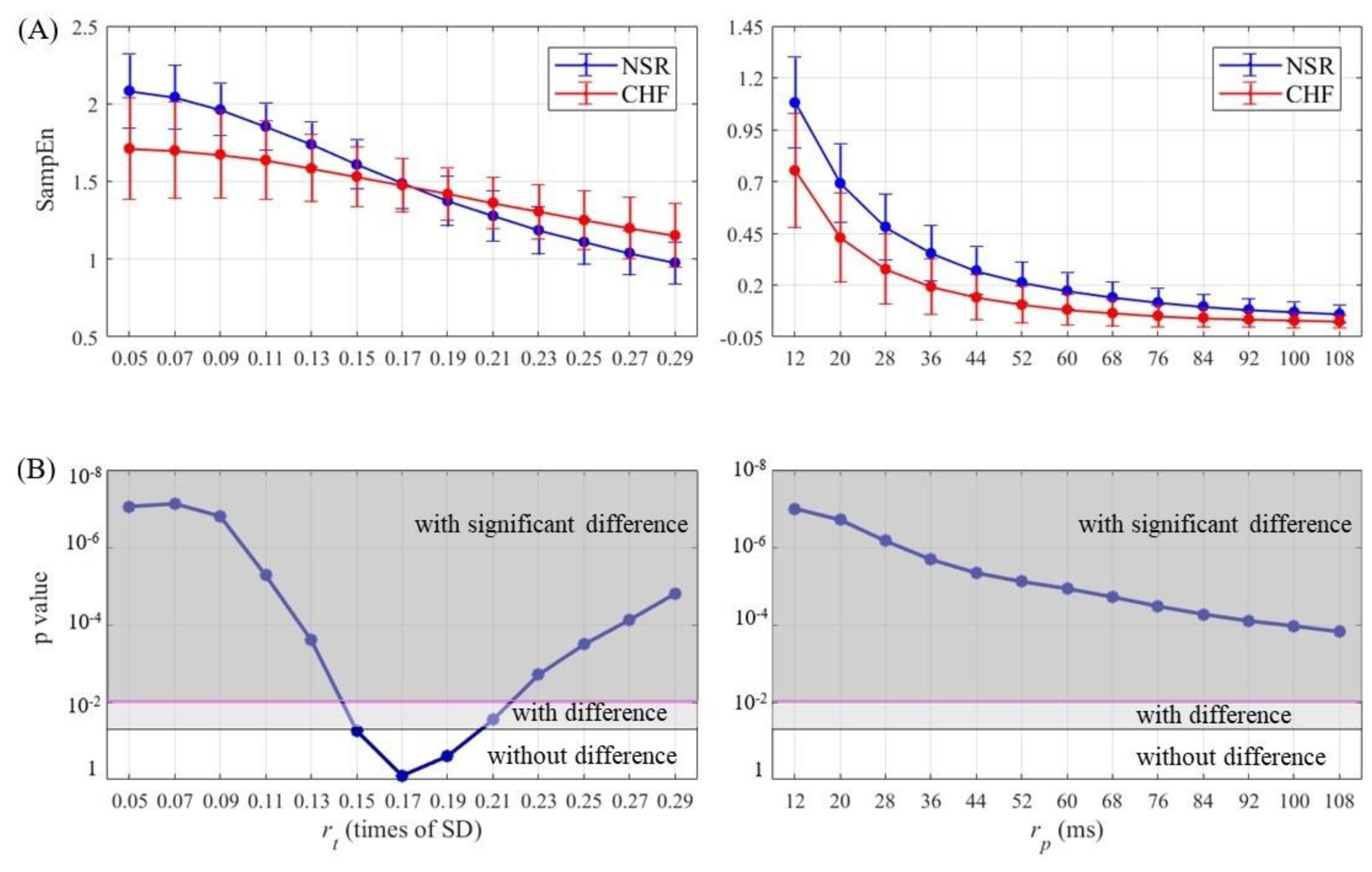

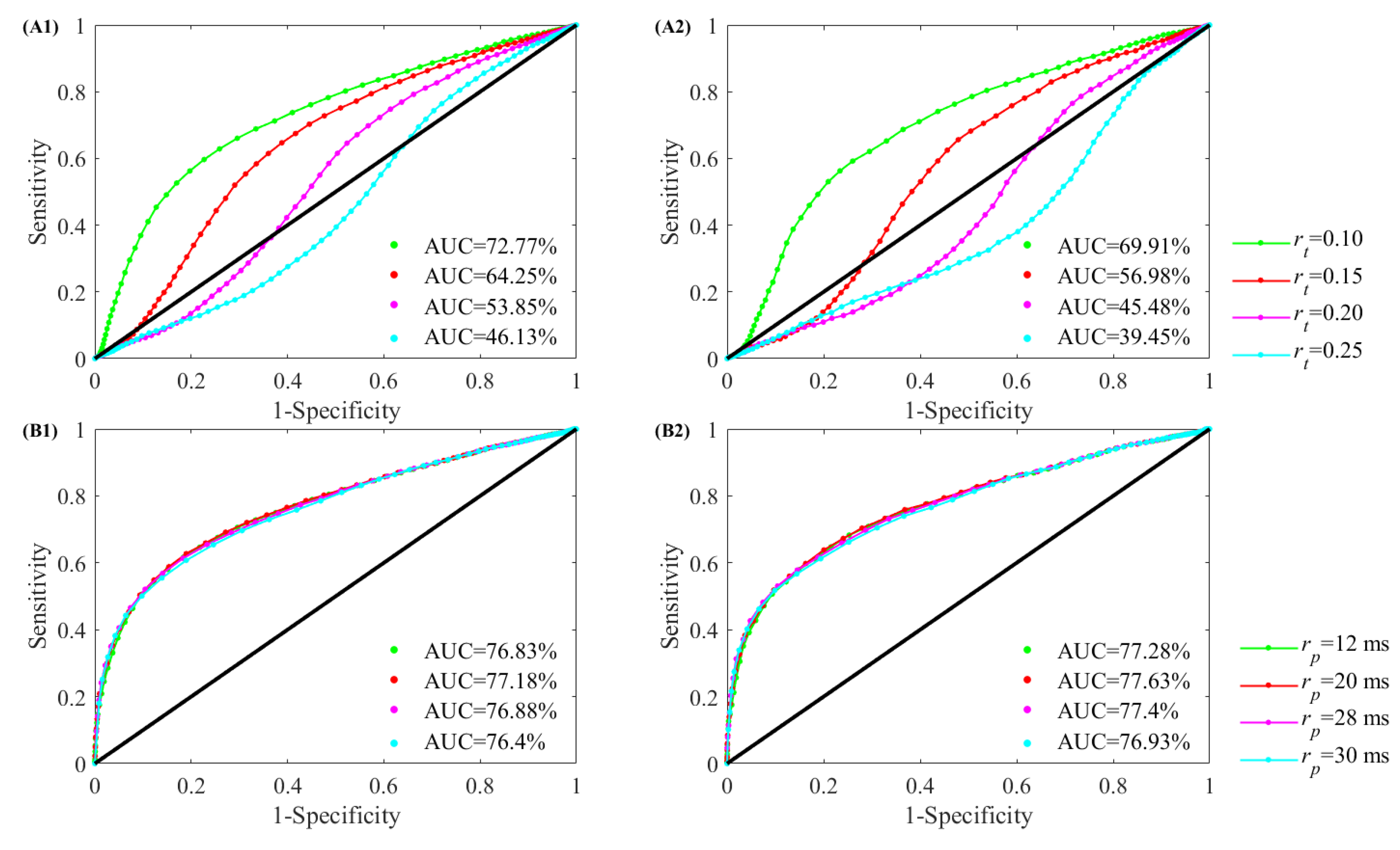
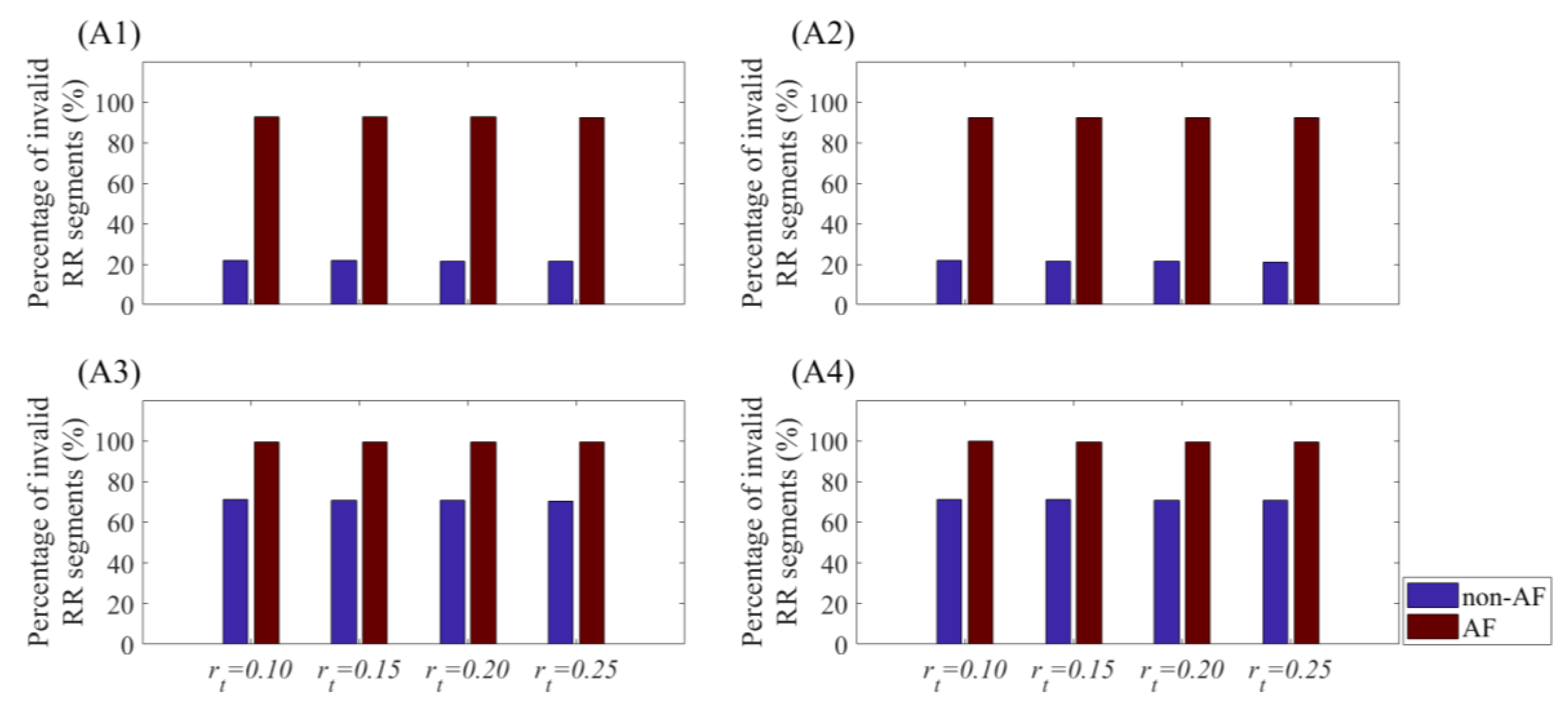
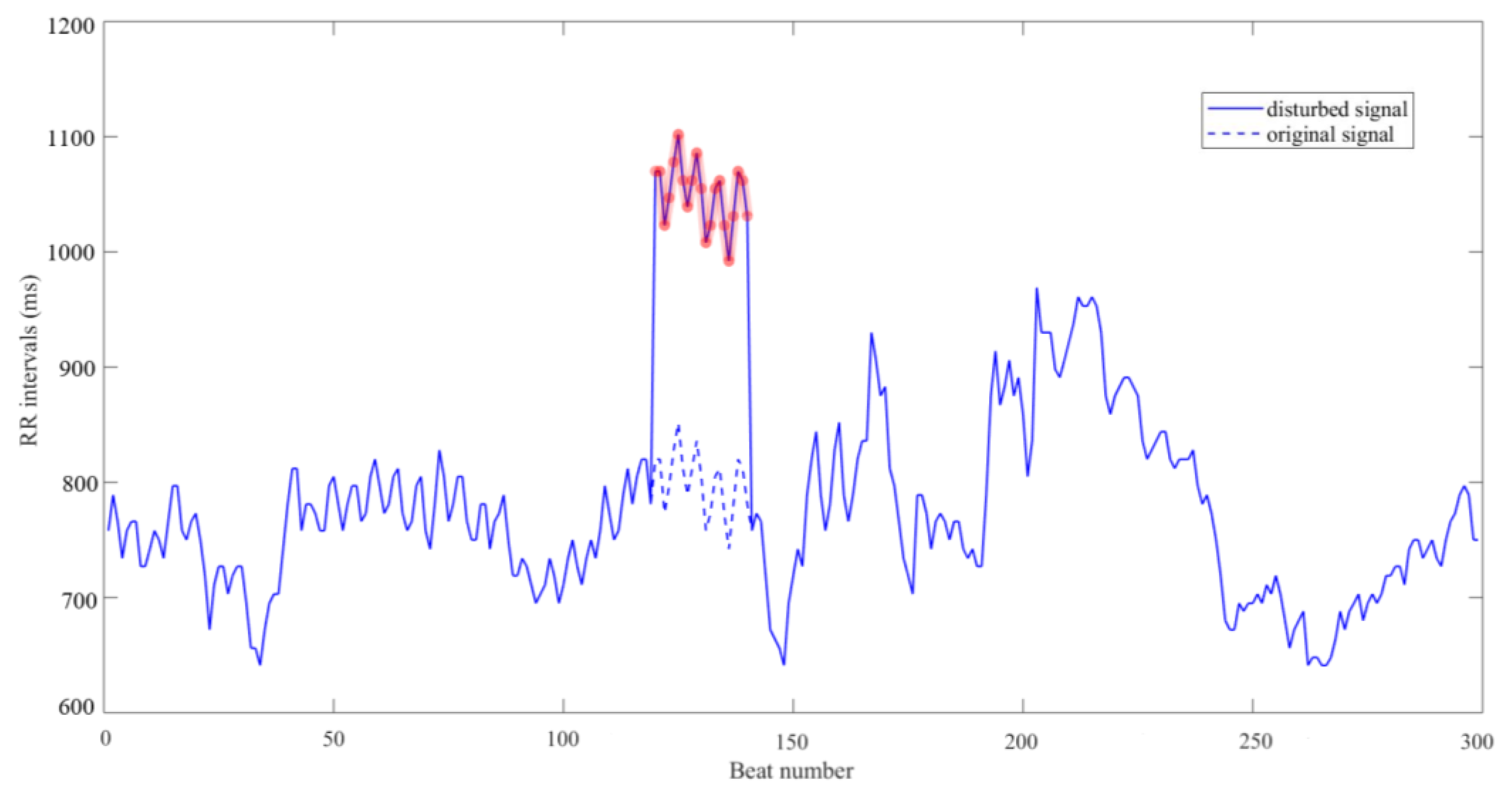
| Variables | NSR Group | CHF Group |
|---|---|---|
| Name of RR interval recordings | nsr001–nsr054 | chf201–chf229 |
| No. of RR interval recordings | 54 | 29 |
| No. of RR intervals | 5,790,504 | 3,312,195 |
| No. of RR intervals after removing greater than 2 s | 5,780,148 | 3,306,394 |
| No. of RR intervals after removing abnormal heartbeats | 5,738,937 | 3,102,120 |
| No. of RR segments when setting N = 300 | 19,101 | 10,324 |
| No. of RR segments when setting N = 1000 | 5711 | 3089 |
| Variable | AF Rhythm | Non-AF Rhythm |
|---|---|---|
| No. of rhythm episodes | 406 (16.9%) | 1999 (83.1%) |
| No. of RR intervals | 533,085 (8.3%) | 5,892,134 (91.7%) |
| No. of RR intervals after removing greater than 2 s | 533,029 (7.5%) | 6,529,842 (92.5%) |
| No. of RR segments (30-beat) | 17,591 (7.4%) | 218,798 (92.6%) |
| No. of RR segments (60-beat) | 8709 (7.4%) | 109,215 (92.6%) |
| Threshold Value | Group | N = 300 | N = 1000 | N = 5000 | N = 10,000 | ||||
|---|---|---|---|---|---|---|---|---|---|
| m = 1 | m = 2 | m = 1 | m = 2 | m = 1 | m = 2 | m = 1 | m = 2 | ||
| Traditional | |||||||||
| = 0.10 | NSR | 1.95 ± 0.18 | 1.84 ± 0.17 | 1.91 ± 0.16 | 1.80 ± 0.15 | 1.76 ± 0.45 | 1.63 ± 0.46 | 1.66 ± 0.48 | 1.53 ± 0.49 |
| CHF | 1.64 ± 0.30 | 1.51 ± 0.31 | 1.66 ± 0.27 | 1.53 ± 0.29 | 1.63 ± 0.34 | 1.49 ± 0.36 | 1.63 ± 0.33 | 1.48 ± 0.35 | |
| p-value | 4 × 10−8 ** | 7 × 10−8 ** | 7 × 10−7 ** | 3 × 10−7 ** | 5 × 10−9 ** | 1 × 10−11 ** | 0.32 | 0.08 | |
| = 0.15 | NSR | 1.73 ± 0.14 | 1.64 ± 0.13 | 1.61 ± 0.16 | 1.50 ± 0.15 | 1.33 ± 0.46 | 1.22 ± 0.45 | 1.18 ± 0.42 | 1.07 ± 0.42 |
| CHF | 1.55 ± 0.23 | 1.44 ± 0.31 | 1.53 ± 0.19 | 1.40 ± 0.20 | 1.42 ± 0.46 | 1.28 ± 0.36 | 1.36 ± 0.35 | 1.22 ± 0.36 | |
| p-value | 2 × 10−5 ** | 5 × 10−6 ** | 0.055 | 0.013 * | 2 × 10−5 ** | 6 × 10−3 ** | 1 × 10−9 ** | 1 × 10−6 ** | |
| = 0.20 | NSR | 1.49 ± 0.15 | 1.40 ± 0.14 | 1.33 ± 0.16 | 1.23 ± 0.15 | 1.05 ± 0.38 | 0.95 ± 0.38 | 0.95 ± 0.33 | 0.85 ± 0.33 |
| CHF | 1.45 ± 0.18 | 1.34 ± 0.18 | 1.39 ± 0.17 | 1.27 ± 0.17 | 1.24 ± 0.38 | 1.10 ± 0.38 | 1.18 ± 0.37 | 1.04 ± 0.36 | |
| p-value | 0.26 | 0.10 | 0.091 | 0.31 | 8 × 10−21 ** | 7 × 10−14 ** | 3 × 10−19 ** | 2 × 10−13 ** | |
| = 0.25 | NSR | 1.28 ± 0.15 | 1.19 ± 0.14 | 1.11 ± 0.15 | 1.02 ± 0.13 | 0.87 ± 0.32 | 0.78 ± 0.32 | 0.78 ± 0.29 | 0.69 ± 0.29 |
| CHF | 1.33 ± 0.17 | 1.23 ± 0.17 | 1.25 ± 0.19 | 1.13 ± 0.18 | 1.06 ± 0.39 | 0.93 ± 0.39 | 0.98 ± 0.39 | 0.85 ± 0.38 | |
| p-value | 0.14 | 0.35 | 3 × 10−4 ** | 0.003 ** | 2 × 10−26 ** | 1 × 10−17 ** | 2 × 10−16 ** | 3 × 10−11 ** | |
| Physically Meaningful | |||||||||
| = 12 ms | NSR | 1.06 ± 0.22 | 0.97 ± 0.21 | 1.08 ± 0.22 | 0.99 ± 0.20 | 1.10 ± 0.33 | 0.99 ± 0.32 | 1.11 ± 0.32 | 0.99 ± 0.31 |
| CHF | 0.72 ± 0.28 | 0.63 ± 0.28 | 0.75 ± 0.28 | 0.65 ± 0.28 | 0.77 ± 0.31 | 0.66 ± 0.32 | 0.79 ± 0.31 | 0.66 ± 0.31 | |
| p-value | 7 × 10−8 ** | 2 × 10−8 ** | 1 × 10−7 ** | 2 × 10−8 ** | 1 × 10−76 ** | 4 × 10−84 ** | 2 × 10−38 ** | 7 × 10−42 ** | |
| = 20 ms | NSR | 0.67 ± 0.19 | 0.60 ± 0.17 | 0.69 ± 0.19 | 0.62 ± 0.18 | 0.71 ± 0.28 | 0.62 ± 0.27 | 0.72 ± 0.27 | 0.63 ± 0.26 |
| CHF | 0.40 ± 0.22 | 0.34 ± 0.21 | 0.43 ± 0.22 | 0.36 ± 0.21 | 0.45 ± 0.25 | 0.36 ± 0.24 | 0.46 ± 0.24 | 0.37 ± 0.24 | |
| p-value | 1 × 10−7 ** | 7 × 10−8 ** | 7 × 10−7 ** | 8 × 10−8 ** | 7 × 10−72 ** | 1 × 10−76 ** | 2 × 10−36 ** | 1 × 10−38 ** | |
| = 28 ms | NSR | 0.46 ± 0.16 | 0.41 ± 0.15 | 0.48 ± 0.16 | 0.42 ± 0.15 | 0.50 ± 0.23 | 0.43 ± 0.22 | 0.51 ± 0.23 | 0.43 ± 0.22 |
| CHF | 0.25 ± 0.17 | 0.21 ± 0.16 | 0.28 ± 0.17 | 0.23 ± 0.16 | 0.30 ± 0.20 | 0.23 ± 0.19 | 0.31 ± 0.19 | 0.24 ± 0.19 | |
| p-value | 5 × 10−7 ** | 4 × 10−7 ** | 2 × 10−6 ** | 4 × 10−7 ** | 4 × 10−65 ** | 6 × 10−67 ** | 4 × 10−33 ** | 4 × 10−34 ** | |
| = 36 ms | NSR | 0.33 ± 0.13 | 0.30 ± 0.12 | 0.35 ± 0.14 | 0.31 ± 0.13 | 0.37 ± 0.20 | 0.32 ± 0.19 | 0.38 ± 0.19 | 0.32 ± 0.18 |
| CHF | 0.17 ± 0.13 | 0.15 ± 0.12 | 0.19 ± 0.13 | 0.16 ± 0.12 | 0.21 ± 0.16 | 0.17 ± 0.15 | 0.22 ± 0.16 | 0.17 ± 0.15 | |
| p-value | 2 × 10−6 ** | 2 × 10−6 ** | 5 × 10−6 ** | 2 × 10−6 ** | 1 × 10−59 ** | 3 × 10−60 ** | 1 × 10−30 ** | 5 × 10−31 ** | |
| Threshold Value | Group | BWL30 | BWL60 | ||
|---|---|---|---|---|---|
| m = 1 | m = 2 | m = 1 | m = 2 | ||
| Traditional | |||||
| = 0.10 | AF | 2.01 ± 0.50 | 1.19 ± 0.48 | 2.03 ± 0.50 | 1.13 ± 0.50 |
| non-AF | 2.24 ± 0.57 | 1.38 ± 0.48 | 2.24 ± 0.57 | 1.40 ± 0.49 | |
| p-value | 4 × 10−8 ** | 4 × 10−8 ** | 5 × 10−9 ** | 0.32 | |
| = 0.15 | AF | 2.01 ± 0.50 | 1.19 ± 0.49 | 2.03 ± 0.50 | 1.13 ± 0.49 |
| non-AF | 2.24 ± 0.58 | 1.38 ± 0.48 | 2.23 ± 0.57 | 1.40 ± 0.49 | |
| p-value | 2 × 10−5 ** | 2 × 10−5 ** | 2 × 10−5 ** | 1 × 10−9 ** | |
| = 0.20 | AF | 2.01 ± 0.50 | 1.21 ± 0.49 | 2.03 ± 0.50 | 1.16 ± 0.49 |
| non-AF | 2.24 ± 0.58 | 1.38 ± 0.48 | 2.23 ± 0.57 | 1.40 ± 0.49 | |
| p-value | 0.26 | 0.26 | 8 × 10−21 ** | 3 × 10−19 ** | |
| = 0.25 | AF | 2.02 ± 0.50 | 1.23 ± 0.50 | 2.04 ± 0.50 | 1.16 ± 0.50 |
| non-AF | 2.23 ± 0.58 | 1.38 ± 0.48 | 2.23 ± 0.57 | 1.39 ± 0.49 | |
| p-value | 0.14 | 0.14 | 2 × 10−26 ** | 2 × 10−16 ** | |
| Physically Meaningful | |||||
| = 12 ms | AF | 1.41 ± 0.49 | 1.34 ± 0.54 | 1.41 ± 0.33 | 1.34 ± 0.32 |
| non-AF | 0.18 ± 0.25 | 0.72 ± 0.23 | 0.18 ± 0.31 | 0.16 ± 0.31 | |
| p-value | 7 × 10−8 ** | 7 × 10−8 ** | 1 × 10−76 ** | 2 × 10−38 ** | |
| = 20 ms | AF | 0.98 ± 0.38 | 1.00 ± 0.45 | 0.98 ± 0.28 | 1.00 ± 0.27 |
| non-AF | 0.11 ± 0.20 | 0.40 ± 0.18 | 0.11 ± 0.25 | 0.10 ± 0.24 | |
| p-value | 1 × 10−7 ** | 1 × 10−7 ** | 7 × 10−72 ** | 2 × 10−36 ** | |
| = 28 ms | AF | 0.72 ± 0.32 | 0.46 ± 0.36 | 0.73 ± 0.23 | 0.73 ± 0.23 |
| non-AF | 0.09 ± 0.17 | 0.25 ± 0.16 | 0.09 ± 0.20 | 0.08 ± 0.19 | |
| p-value | 5 × 10−7 ** | 5 × 10−7 ** | 4 × 10−65 ** | 4 × 10−33 ** | |
| = 36 ms | AF | 0.55 ± 0.28 | 0.33 ± 0.30 | 0.55 ± 0.20 | 0.55 ± 0.19 |
| non-AF | 0.08 ± 0.15 | 0.17 ± 0.15 | 0.07 ± 0.16 | 0.07 ± 0.16 | |
| p-value | 2 × 10−6 ** | 2 × 10−6 ** | 1 × 10−59 ** | 1 × 10−30 ** | |
| Threshold Value | Group | N = 300 | N = 1000 | ||
|---|---|---|---|---|---|
| m = 1 | m = 2 | m = 1 | m = 2 | ||
| Traditional | |||||
| = 0.10 | NSR | 8.01% ± 3.11% | 9.40% ± 3.23% | 2.74% ± 1.22% | 3.09% ± 1.36% |
| CHF | 4.19% ± 3.37% | 4.88% ± 3.44% | 1.38% ± 1.41% | 1.49% ± 1.35% | |
| = 0.15 | NSR | 34.16% ± 7.58% | 35.34% ± 7.85% | 9.15% ± 2.64% | 9.46% ± 2.64% |
| CHF | 39.57% ± 9.13% | 40.50% ± 11.72% | 5.09% ± 3.89% | 5.45% ± 4.06% | |
| = 0.20 | NSR | 32.62% ± 10.38% | 33.79% ± 11.12% | 14.10% ± 5.53% | 14.80% ± 6.03% |
| CHF | 51.67% ± 15.50% | 53.81% ± 16.09% | 13.93% ± 8.00% | 15.37% ± 8.57% | |
| = 0.25 | NSR | 33.44% ± 10.25% | 35.38% ± 11.92% | 14.76% ± 6.97% | 15.34% ± 7.07% |
| CHF | 52.84% ± 15.79% | 54.81% ± 16.13% | 28.79% ± 16.71% | 30.29% ± 17.13% | |
| Physically Meaningful | |||||
| = 12 ms | NSR | 1.66% ± 0.19% | 2.04% ± 0.25% | 0.52% ± 0.07% | 0.61% ± 0.09% |
| CHF | 2.46% ± 0.93% | 2.73% ± 0.91% | 0.72% ± 0.22% | 0.83% ± 0.25% | |
| = 20 ms | NSR | 2.41% ± 0.49% | 2.82% ± 0.55% | 0.71% ± 0.11% | 0.84% ± 0.16% |
| CHF | 5.78% ± 7.85% | 6.31% ± 7.94% | 1.33% ± 0.89% | 1.55% ± 1.00% | |
| = 28 ms | NSR | 5.23% ± 9.20% | 5.82% ± 9.70% | 0.97% ± 0.20% | 1.14% ± 0.25% |
| CHF | 17.69% ± 24.66% | 18.77% ± 24.69% | 1.88% ± 2.02% | 2.11% ± 2.18% | |
| = 36 ms | NSR | 8.68% ± 11.05% | 9.64% ± 11.90% | 1.57% ± 1.94% | 1.81% ± 2.01% |
| CHF | 31.62% ± 28.61% | 33.48% ± 29.46% | 9.53% ± 16.70% | 12.83% ± 22.59% | |
© 2019 by the authors. Licensee MDPI, Basel, Switzerland. This article is an open access article distributed under the terms and conditions of the Creative Commons Attribution (CC BY) license (http://creativecommons.org/licenses/by/4.0/).
Share and Cite
Xiong, J.; Liang, X.; Zhu, T.; Zhao, L.; Li, J.; Liu, C. A New Physically Meaningful Threshold of Sample Entropy for Detecting Cardiovascular Diseases. Entropy 2019, 21, 830. https://doi.org/10.3390/e21090830
Xiong J, Liang X, Zhu T, Zhao L, Li J, Liu C. A New Physically Meaningful Threshold of Sample Entropy for Detecting Cardiovascular Diseases. Entropy. 2019; 21(9):830. https://doi.org/10.3390/e21090830
Chicago/Turabian StyleXiong, Jinle, Xueyu Liang, Tingting Zhu, Lina Zhao, Jianqing Li, and Chengyu Liu. 2019. "A New Physically Meaningful Threshold of Sample Entropy for Detecting Cardiovascular Diseases" Entropy 21, no. 9: 830. https://doi.org/10.3390/e21090830
APA StyleXiong, J., Liang, X., Zhu, T., Zhao, L., Li, J., & Liu, C. (2019). A New Physically Meaningful Threshold of Sample Entropy for Detecting Cardiovascular Diseases. Entropy, 21(9), 830. https://doi.org/10.3390/e21090830






